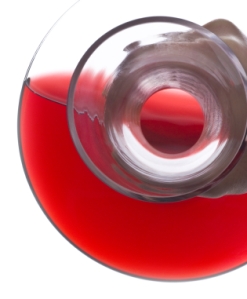You are currently browsing the tag archive for the ‘oxidation’ tag.
A friend recently asked me, “What are your thoughts on wine aerators? I find that I will open a bottle of wine, and not like it, but then 3 days later when I go back to it, it tastes delicious. Can you explain this phenomenon? Would an aerator assist me in making the wine tasty, quickly?”
A simply super set of questions. First of all, what exactly is a wine aerator? Here’s a link to a very popular one, the Vinturi. Read notable wine blogger Josh Wade’s review of this product here.
The purpose a device like the aerator and the purpose of a decanter are the same: to allow the wine to “breathe.” During the wine-making process, it is crucial that the wine is not exposed to too much oxygen for risk of oxidation. Oxidation, at that point in time is a bad things. It is the result of the phenols in the wine (I’ll get to what those are in just a moment) chemically reacting with oxygen and resulting in unfavorable characteristics such as a dull, brownish color and aromas like stale nuts and bad fruit. Oxidation is one of many conditions that falls under the umbrella term “corked.” Jumping back briefly – phenols are the chemical base composed of C6H5OH. Long story short, they are present throughout the grape and vine structure in the skins, stems, seeds & juice and end up in your wine. Controlled amounts of oxygen can result in aromas and flavors that we want, too much, however, will make us send that bottle back. This balance is one of the many challenges that a wine maker faces.
After wine has been resting in a bottle for anywhere from two days to twenty years, a bit of oxygen generally does it some good. By pouring our bottle of wine into a decanter, pouring it through an aerator or by swirling it in our glass we are exposing the phenols to oxygen — same thing as oxidation really, but when this effect is desired we tend to call it aeration instead. The true benefits of aeration are quite hotly contested in the wine industry. The late Professor Emile Peynaud – a forefather and scientist of oenology (wine-making) – argued that aeration does nothing for wine but allow the desirable attributes to fade and that there is no science supporting otherwise. Well hmph. Many seasoned wine tasters feel otherwise. One of the benefits of decanting or just letting your wine set in your glass for a while is temperature. Temperature and wine will be a whole other post, but generally red is best between 59 and 54 degrees F. White or Rose is best around 43 to 50 degrees F. Having a wine too cold limits the flavor components from evaporating. Just like you can smell the tar on the road during a hot summer day, so better can you smell and taste the notes of a wine when it is warmer and able to evaporate. Other than temperature, aeration and wine just seem to work. It is as if the oxygen unlocks the phenols and allows us to experience the wine much more fully than when first opening the bottle, though science suggests otherwise. As with most things, there is no right answer and wrong answer with oxygen and your glass of wine. I think Maynard Amerine (plant physiologist who moved California wine back onto the map after Prohibition) may have summed it up best when he said, “Quality in wines is much easier to recognize than to define.”
So back to the original question: to aerate or not to aerate. It all depends. I advise to give every bottle a chance before tampering with it at all. Old wines of a delicate nature could fall apart if exposed to too much oxygen after opening. Others will flourish. Try to serve your wine at optimum temperature and then let your intuition decide if it needs to run through the decanter, rest in your glass or even make that slurpy noise through the aerator.


